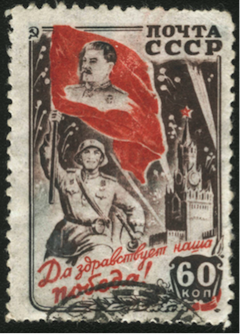

|
The Clampdown of 1945  Victory stamp The leadership was anxious about what would happen when these men came back from war. They saw a historical parallel with the war against Napoleon in 1812-15, when officers returned to tsarist Russia with Western ideas of liberal reform which inspired the Decembrist uprising of 1825. They dealt with the threat through a mixture of repression and concessions. On their return from Europe, Soviet servicemen were interrogated by the NKVD in 'filtration' camps, where those with potentially subversive views and 'collaborators' with the enemy were weeded out and sent to the Gulag. But after their return former servicemen were given priority access to universities and colleges on the strength of their military record. There was no reform in 1945. The ending of the war meant a return to the autarky and austerity of the Five Year Plan to rebuild the devastated Soviet economy. Ideologically the Stalinist regime tightened its control to arm the Soviet Union for the struggle with the West in the Cold War. At a banquet for his senior commanders on 24 May Stalin made a famous toast to the 'tens of millions' of 'simple, ordinary, modest people...who are the little screws (vintiki) in the great mechanism of the state.' With these words the popular conception of the Great Patriotic War as a 'people's war' - which had taken root as a potential challenge to the Soviet dictatorship - was officially dismissed. From now on the victory of 1945 would be commemorated as the justifying myth of Soviet power and everything it had accomplished after 1917. The Great Patriotic War replaced Great October as the main foundation myth of the Soviet state. |
© 2014 Orlando Figes | All Rights Reserved